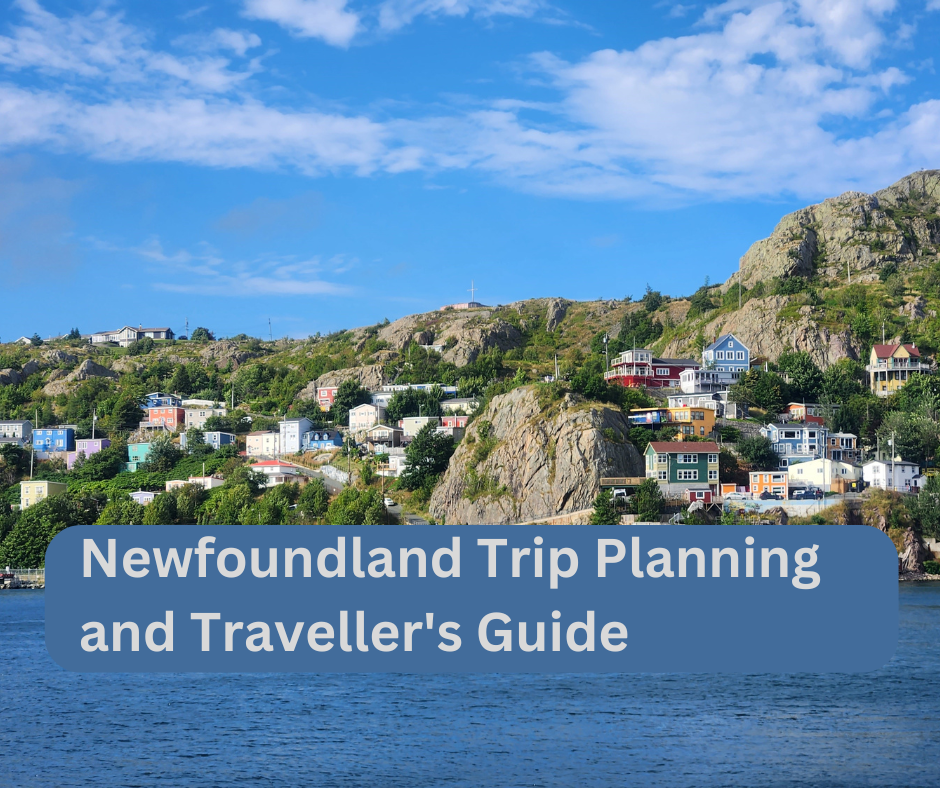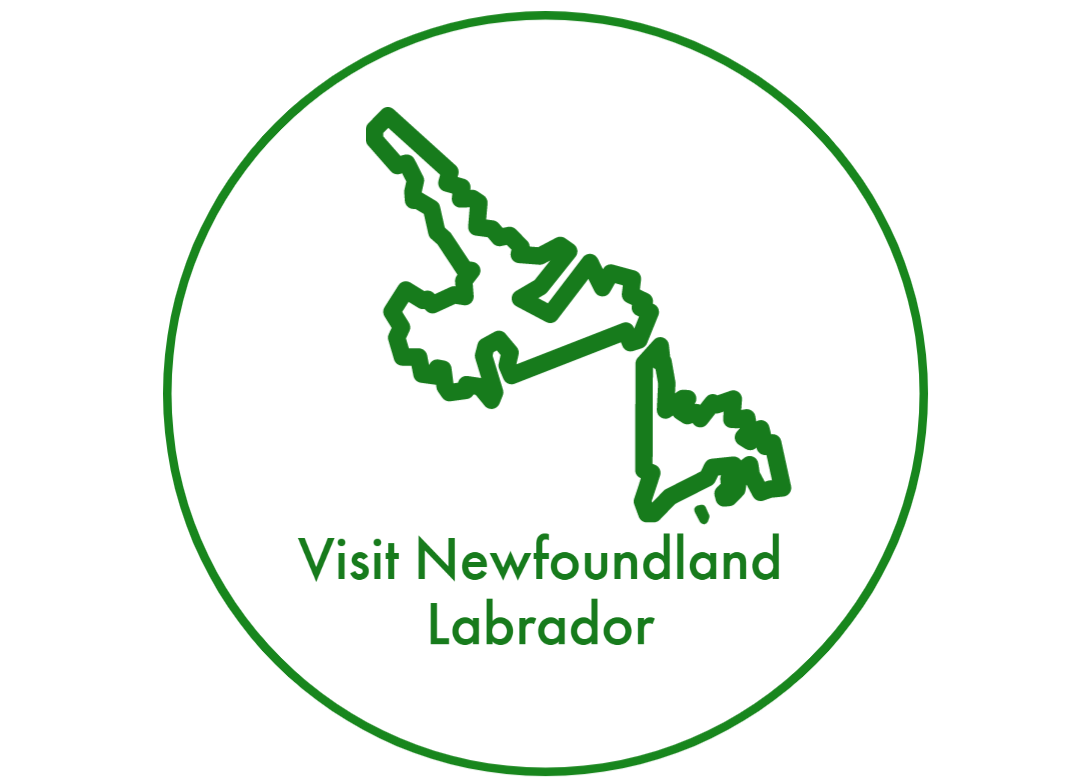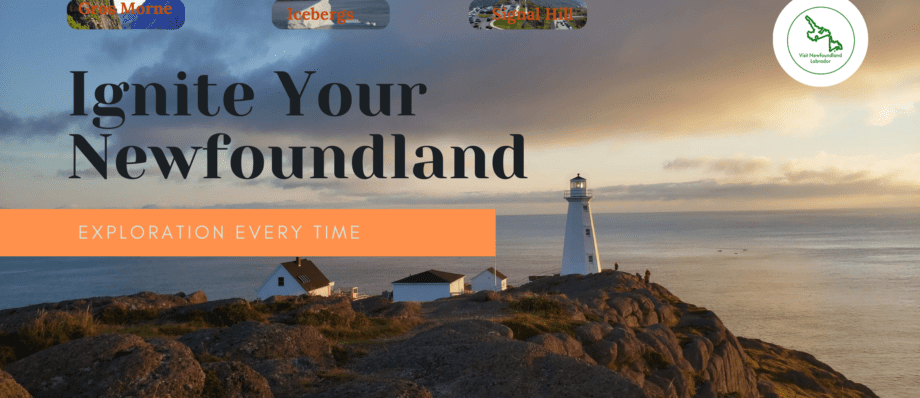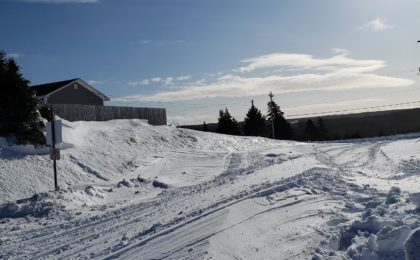10 Epic Stops to Ignite Your Newfoundland Exploration every time
These are 10 Epic Stops to Ignite Your Newfoundland Exploration Every Time. Newfoundland, affectionately nicknamed “The Rock,” is a Canadian province unlike any other. Cradled by the mighty Atlantic Ocean, Newfoundland boasts a rugged coastline, dramatic fjords, and a vibrant culture steeped in history, music, and folklore. To help you plan your unforgettable Newfoundland adventure, here are must-visit places that encapsulate the essence of this captivating province:
1. St. John’s: A Bustling Capital Steeped in History
Your Newfoundland odyssey likely begins in St. John’s, the vibrant capital city. Stroll down the colourful jellybean row houses of Quidi Vidi Village, a picture-perfect fishing community. Hike to the summit of Signal Hill National Historic Site for panoramic vistas and a glimpse of the impressive Cabot Tower, commemorating explorer John Cabot’s arrival in 1497. Immerse yourself in Newfoundland rich history at The Rooms, a phenomenal provincial museum showcasing art, archaeology, and cultural artifacts. Indulge in the city’s renowned culinary scene, savouring fresh seafood chowder and indulging in local craft beers at lively pubs brimming with Newfoundland hospitality.
2. Gros Morne National Park: A UNESCO World Heritage Site of Unearthly Beauty
Venture westward to Gros Morne National Park, a World Heritage Site renowned for its inspiring fjords, towering mountains, and unique geological formations. Hike the challenging yet rewarding Gros Morne Mountain Trail, offering breathtaking panoramas of the park. Enjoy a boat tour on Western Brook Pond, a majestic fjord carved by glaciers millions of years ago. Explore the Tablelands, a barren plateau where the Earth’s mantle is exposed, creating an otherworldly landscape. Kayaking, wildlife watching, and camping are just a few other adventures that await in this natural wonderland.
3. L’Anse aux Meadows: A Viking Voyage Through Time
Step back at L’Anse aux Meadows National Historic Site, a World Heritage Site and the only confirmed evidence of Viking settlement in North America. Explore reconstructed Viking longhouses, wander the archaeological dig sites, and delve into the fascinating history of Norse exploration across the Atlantic Ocean. Imagine these intrepid explorers setting sail across the vast ocean, their legacy forever etched in Newfoundland’s landscape.
4. Bonavista: Where History Meets Breathtaking Scenery
The historic town of Bonavista boasts a rich past, evident in its colourful fishing stages and a century-old lighthouse. Explore the fascinating Town of Bonavista Battery with stunning ocean views and historic homes. This charming town is also a renowned spot for whale watching, with humpbacks, puffins, and other marine life frequently gracing the waters.
5. Fogo Island: A Remote Escape with Unparalleled Charm
Embark on a ferry journey to Fogo Island, an isolated yet captivating island community. Stay in a one-of-a-kind “Fogo Island Inn,” a unique architectural marvel designed to blend seamlessly with the natural landscape. Explore the rugged coastline dotted with charming fishing villages and dramatic cliffs. Hike scenic trails, Kayak in pristine waters, and delve into this remote island community’s unique culture and traditions.
6. Terra Nova National Park: A Picturesque Playground for Outdoor Enthusiasts
Terra Nova National Park, located on the province’s central shore, is a haven for outdoor enthusiasts. Hike the scenic trails through towering forests and along the dramatic coastline—Kayak in the calm waters around Newman Sound campground, teeming with marine life. Go bird-watching and spot many feathered friends, including eagles and ptarmigans. Camp under the star-studded sky and experience the serenity of this untouched wilderness.
7. Twillingate: The Iceberg Capital of the World

Nicknamed the “Iceberg Capital of the World,” Twillingate offers a front-row seat to these inspiring giants of the sea. Set out on a boat tour and marvel at the majestic icebergs sculpted by glaciers drifting south from the Labrador Sea. Explore the historic fishing community, with its colourful houses lining the harbour. Whale watching, kayaking, and boat tours are just a few of the adventures that await in this charming coastal town.
8. Red Bay: A Journey Through Basque Whaling History
Explore the fascinating Basque whaling station, featuring reconstructed workshops, ship sheds, and try-works used to process whale blubber. Learn about the lives and culture of the Basque whalers who braved the treacherous Atlantic to pursue these magnificent creatures. Red Bay boasts a beautiful harbour and surrounding coastline, perfect for hiking, kayaking, and wildlife watching.
9. Trinity: A Picturesque Harbour Town Steeped in Tradition
Nestled on the province’s eastern coast, Trinity is a charming town steeped in history and tradition. Wander the colourful streets lined with restored heritage buildings. Discover the dramatic coastline dotted with sea stacks and rock formations.
10. Skerwink Trail: A Hike Through Newfoundland Wild Beauty
For the truly adventurous, the Skerwink Trail offers a challenging yet rewarding hike along Newfoundland rugged coastline. This trail winds through meadows, forests, and dramatic cliffs, offering breathtaking ocean views. As you conquer this iconic Newfoundland hike, prepare for diverse weather conditions and stunning scenery.
Beyond the Must-Visit Places:
Newfoundland offers a plethora of other experiences waiting to be discovered. Explore the vibrant nightlife of St. John’s, delve into the province’s rich musical heritage, or embark on a puffin-watching tour. Sample the local cuisine, renowned for its fresh seafood dishes, and remember to try a slice of Newfoundland famous touton (fried dough bread).
More Ways to Explore Newfoundland and Labrador
- The Best Time For Exploring the Wonders of Newfoundland
- Crossing On The Marine Atlantic Ferry Is The Best
- Best Places To Travel In 2024 For An Amazing Experience
- The Best Amazing Restaurants in St. John’s to Eat Out
What is Newfoundland known for?
Newfoundland is known for its stunning scenery, including fjords, mountains, and a rugged coastline. It’s also famous for its rich history, unique culture, and friendly people.
What is the best time to visit Newfoundland?
The best time to visit Newfoundland depends on your preferences. Summer offers hot weather and plenty of outdoor activities, while fall boasts beautiful fall foliage. Winter is a great time for whale watching and experiencing the province’s unique winter festivals.
How do you get to Newfoundland?
You can get to Newfoundland by plane, with St. John’s International Airport being the main entry point. There are also ferry connections from Sydney, Nova Scotia.
Is Newfoundland safe to visit?
Newfoundland is a very safe province to visit. However, as with any travel destination, it’s always a good idea to be aware of your surroundings and take precautions.
What are some things to pack for a trip to Newfoundland?
Pack for changing weather conditions, including rain gear, warm clothes, and layers. Pack comfortable walking shoes or hiking boots, sunscreen, and insect repellent.
What are some things to do in Newfoundland besides sightseeing?
There are plenty of things to do in Newfoundland besides sightseeing. You can go hiking, kayaking, whale watching, iceberg viewing, fishing, and much more.
What is the food like in Newfoundland?
Newfoundland cuisine is known for its fresh seafood dishes, cod tongues, fish and chips, and chowder. Other popular Newfoundland dishes include:
- Touton (fried dough bread).
- Moose stew.
- Jiggs’ dinner (a boiled dinner with salt beef, vegetables, and pease pudding).
What are some festivals and events in Newfoundland?
Newfoundland has a vibrant festival scene throughout the year. Some popular events include the George Street Festival (St. John’s), the Royal St. John’s Regatta (North America’s oldest sporting event), and the Newfoundland and Labrador Folk Festival.
Travelling to Newfoundland and Labrador. Travelers also ask.

Can you see icebergs in Newfoundland now?
Icebergs are typically seen off the coast of Newfoundland from late spring to early summer. The best months for iceberg viewing are usually May and June. If it’s within this timeframe, you can likely see icebergs, especially in areas like Twillingate and St. Anthony.
When to see icebergs in Twillingate?
The prime time to see icebergs in Twillingate is from late May to early June. This period offers the highest likelihood of witnessing these massive ice formations as they drift southward along the coast.
Where is the best place to see icebergs?
The best places to see icebergs in Newfoundland include Twillingate, St. Anthony, Bonavista, and Fogo Island. Twillingate is often called the “Iceberg Capital of the World” due to its high iceberg count and accessibility.
What is the best month to see icebergs in Newfoundland?
The best month to see icebergs in Newfoundland is May. During this month, the icebergs are plentiful, and the weather is often more favourable for boat tours and coastal viewing.
How long do icebergs last in Newfoundland?
Icebergs can last from a few weeks to several months in Newfoundland waters. Their longevity depends on their size, the water temperature, and the weather conditions. Typically, icebergs seen off Newfoundland begin their journey from Greenland and take about 1-2 years to reach the island.
Where is Newfoundland Iceberg Alley?
Iceberg Alley refers to the stretch of ocean off the coast of Newfoundland and Labrador, where icebergs are commonly seen. It extends from the coast of Labrador down through Newfoundland’s eastern shore, including areas like Twillingate, St. Anthony, and Bonavista.
Are there icebergs in Newfoundland in August?
By August, the number of icebergs in Newfoundland significantly decreases. While it’s possible to see the occasional iceberg, they are much rarer than the peak months of May and June.
What month is the warmest in Newfoundland?
July is typically the warmest month in Newfoundland, with a temperatures ranging from 15°C to 20°C. This makes it a popular time for visitors seeking to explore the island’s natural beauty.
Where to see whales in Newfoundland?
Whale watching is popular in Newfoundland from June to September. The best locations include St. John’s, Trinity, Bonavista, and Witless Bay Ecological Reserve, renowned for its abundant marine life, including humpback whales.
Can you see the Northern Lights from Newfoundland?
You can see the Northern Lights from Newfoundland, particularly in the more northern and remote parts of the island. The best times are during the fall and winter when the nights are the longest and the skies are the darkest.
How close to Newfoundland did the Titanic sink?
The Titanic sank about 370 miles south-southeast off the coast of Newfoundland. The nearest land to the wreck site is the southeastern tip of Newfoundland.
How close is the Titanic to Newfoundland?
The Titanic’s wreck is located approximately 370 miles off the coast of Newfoundland. This proximity made Newfoundland a critical point in the communication and rescue efforts following the disaster.
Where did the Titanic sink off Newfoundland?
The Titanic sank in the Atlantic Ocean, approximately 370 miles south-southeast of Newfoundland coast.
Are there polar bears in Newfoundland?
Polar bears are not native to Newfoundland itself, but they occasionally appear on the northern coast of Labrador, particularly when sea ice drifts south from the Arctic.
What is the iceberg capital of Canada?
Twillingate, a small coastal town in Newfoundland, is known as the “Iceberg Capital of the World” due to its frequent and spectacular iceberg sightings during the peak season.
How fast do icebergs move?
Icebergs generally drift at about 0.7 kilometres per hour (0.4 miles per hour). However, their speed can vary depending on ocean currents, winds, and the iceberg’s size.
Why are icebergs sometimes black?
Icebergs appear black when they contain a high amount of sediment and debris. This can occur when icebergs calve off glaciers that scrape the land, picking up rocks and soil, which then get frozen into the ice.
Does the Atlantic Ocean in Newfoundland freeze?
The Atlantic Ocean around Newfoundland does not freeze over due to its relatively warmer temperatures than Arctic waters. However, sea ice and icebergs from the Arctic can drift into Newfoundland waters, especially during the spring.
Are there puffins in Twillingate?
While puffins are not commonly found in Twillingate, they are prevalent in other parts of Newfoundland, such as the Witless Bay Ecological Reserve. Twillingate is more famous for its iceberg and whale sightings.
What is the best time to see whales in NL Newfoundland?
The best time to see whales in Newfoundland is from June to September. Humpback whales, minke whales, and other species migrate through Newfoundland coastal waters during this period.
Is the tip of the iceberg visible?
Yes, the tip of the iceberg is visible above the water, but it represents only about 10% of its total mass. The remaining 90% is submerged underwater, making icebergs particularly dangerous for ships.
Can you see icebergs in Newfoundland in July?
Yes, you can still see icebergs in July in Newfoundland, although they are less common than in May and June. By July, many icebergs have drifted further south or melted.
Where is the best place to see icebergs?
Twillingate, St. Anthony, Bonavista, and Fogo Island are the best places to see icebergs in Newfoundland. These locations offer optimal viewing points and tour opportunities.
How often can you see northern lights in Newfoundland?
The Northern Lights can be seen in Newfoundland several times a year, especially in the fall and winter months. The frequency depends on solar activity and the clarity of the night skies.
Why is it called Iceberg Alley?
The stretch of water known as Iceberg Alley gets its name from the numerous icebergs that travel through this area each year. The icebergs originate from Greenland and drift down the Labrador Current past Newfoundland and Labrador.
When should I visit Iceberg Alley?
The best time to visit Iceberg Alley is from late May to early June. During this period, the highest concentration of icebergs can be seen, offering the most spectacular views.
Can you swim in Newfoundland in August?
Yes, you can swim in Newfoundland in August, especially in the warmer, sheltered areas like lakes and coves. However, the ocean waters remain pretty cold, typically around 12-15°C, so swimming in the sea can be chilly.
How hot is Newfoundland in July?
Newfoundland experiences its warmest weather in July, with a temperatures ranging from 15°C to 20°C. Some days can be warmer, especially inland and away from the coastal breezes.
These are the best travel planning resources you should use.
Looking to book your trip to Newfoundland and Labrador? Use these resources that are tried and tested by other travellers like you who vacation in Newfoundland and Labrador. Bookmark these links. Save them for future reference.
Booking Flights, Hotels or B&B: Start planning your next vacation trip by finding the best flight, hotel or b&b deals. Book Here
Finding things to do in Newfoundland and Labrador on TripAdvisor and Viator is not hard. Enjoy boat tours, whale watching, icebergs watching, kayaking and other activities.
You can also find low prices on hotels, B&B and cabins with these two providers. If you are located in Canada, the USA, the UK or Europe, use Booking.com, and if you are in Canada, the USA or anywhere else, use TripAdvisor.
Car Rental: Here is what we recommend:
When you book with Rentalcars.com, you can compare prices and find the best vehicle for your trip. Economybookings.com Display all their vehicle on the website with a detailed description. They display high-quality photos and a user rating as well. Qeeq.com serves road trip travellers like you from different countries by working with car rental companies worldwide.
Get compensated if your flight is delayed or cancel
AirHelp and Compensateair will help you with flight delays, cancellations, or denied boarding. All you need to do is to submit your flight details, and they will handle the claim process on your behalf. They will handle all the paperwork, airline negotiations, and legal proceedings.
Do you need more help planning your trip?
Check out our Resources Page, where we highlight all the resources and companies you can use to assist with your planning.
Where can I find more information about travelling to Newfoundland and Labrador? Here are helpful resources for planning your trip:
Newfoundland and Labrador Tourism | Travel Canada | The Rooms Provincial Museum



